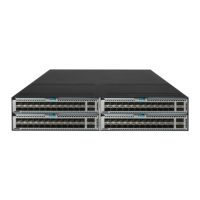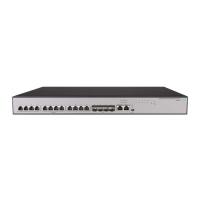75
direction is established. The CRLSPs of a bidirectional MPLS TE tunnel established in
co-routed mode use the same path.
• Associated mode—In this mode, you establish a bidirectional MPLS TE tunnel by binding two
unidirectional CRLSPs in opposite directions. The two CRLSPs can be established in different
modes and use different paths. For example, one CRLSP is established statically and the other
CRLSP is established dynamically by RSVP-TE.
For more information about establishing MPLS TE tunnel through RSVP-TE, the Path message, and
the Resv message, see "
712HConfiguring RSVP."
177BProtocols and standards
• RFC 2702, Requirements for Traffic Engineering Over MPLS
• RFC 3564, Requirements for Support of Differentiated Service-aware MPLS Traffic
Engineering
• RFC 3812, Multiprotocol Label Switching (MPLS) Traffic Engineering (TE) Management
Information Base (MIB)
• RFC 4124, Protocol Extensions for Support of Diffserv-aware MPLS Traffic Engineering
• RFC 4125, Maximum Allocation Bandwidth Constraints Model for Diffserv-aware MPLS Traffic
Engineering
• RFC 4127, Russian Dolls Bandwidth Constraints Model for Diffserv-aware MPLS Traffic
Engineering
• ITU-T Recommendation Y.1720, Protection switching for MPLS networks
• RFC 4655, A Path Computation Element (PCE)-Based Architecture
• RFC 5088, OSPF Protocol Extensions for Path Computation Element Discovery
• RFC 5440, Path Computation Element (PCE) Communication Protocol (PCEP)
• RFC 5441, A Backward-Recursive PCE-Based Computation (BRPC) Procedure to Compute
Shortest Constrained Inter-Domain Traffic Engineering LSP
• RFC 5455, Diffserv-Aware Class-Type Object for the Path Computation Element
Communication Protocol
• RFC 5521, Extensions to the Path Computation Element Communication Protocol (PCEP) for
Route Exclusions
• RFC 5886, A Set of Monitoring Tools for Path Computation Element (PCE)-Based Architecture
• draft-ietf-pce-stateful-pce-07
54B
MPLS TE configuration task list
To configure an MPLS TE tunnel to use a static CRLSP, perform the following tasks:
1. Enable MPLS TE on each node and interface that the MPLS TE tunnel traverses.
2. Create a tunnel interface on the ingress node of the MPLS TE tunnel, and specify the tunnel
destination address—the address of the egress node.
3. Create a static CRLSP on each node that the MPLS TE tunnel traverses.
For information about creating a static CRLSP, see "
713HConfiguring a static CRLSP."
4. On the ingress node of the MPLS TE tunnel, configure the tunnel interface to use the created
static CRLSP.
5. On the ingress node of the MPLS TE tunnel, configure static routing or automatic route
advertisement to direct traffic to the MPLS TE tunnel.

